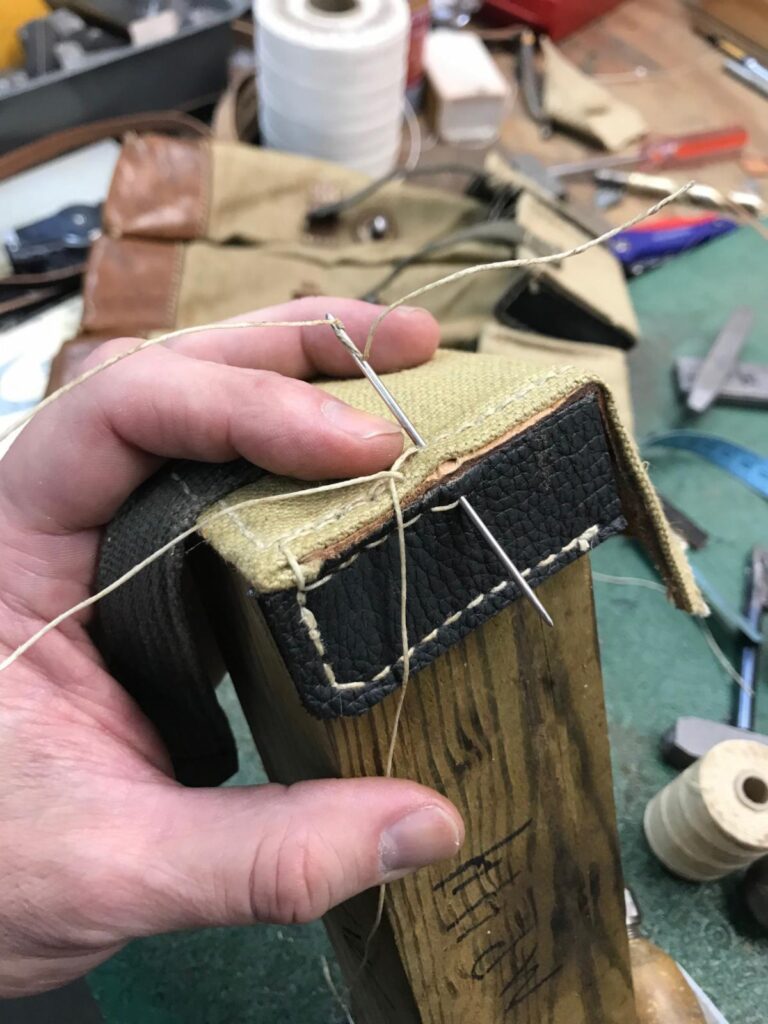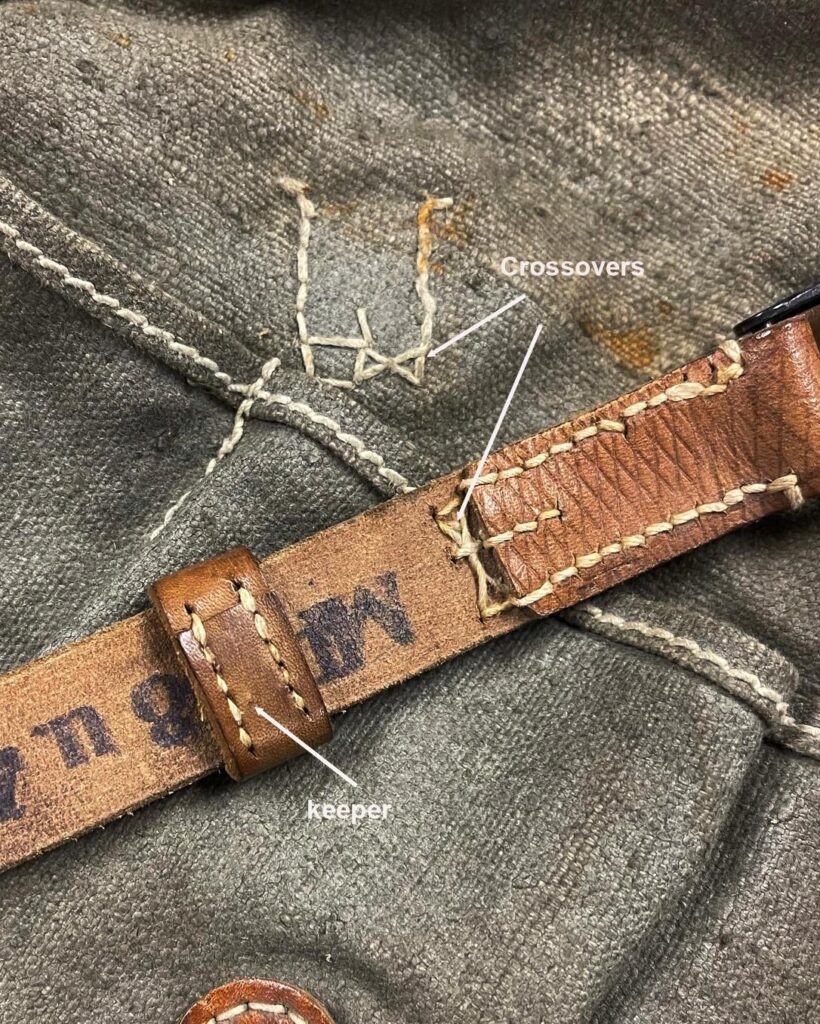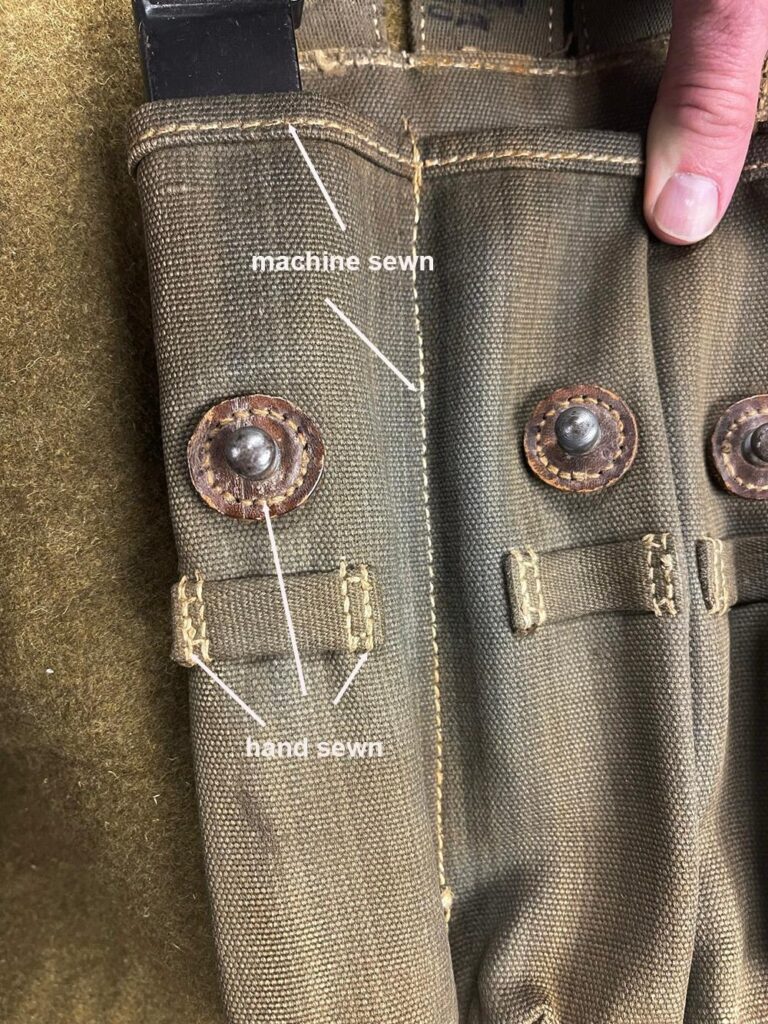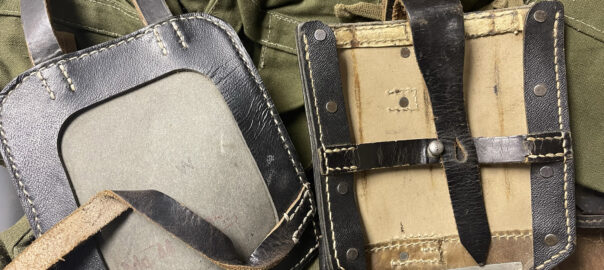The reasons the Allies won WWII have been debated and bandied about for decades and always will be. There are obvious factors, and the not so obvious ones.
Ever since I began making reproductions in the late 1980’s, this one has always stood out. Many enthusiasts are unaware that the Germans stitched much of their equipment by hand, even in 1944-45 when every minute of production time counted. The reasons are not entirely clear, but I assume they were characteristically allergic to abandoning traditional manufacturing methods.
For most of history, garments and gear have been hand stitched. Sewing machines weren’t widely available until the latter half of the 19th Century, but by 1914 the United States and Great Britain were already machine sewing the bulk of their troops’ equipment. This meant largely switching from leather to cotton webbing and canvas for their packs, pouches, and other field gear. Many other militaries continued using leather and retained the older assembly methods.
Nearly all field gear used by the Wehrmacht, is entirely or mostly stitched by hand. K98 pouches, service belts, Y-straps, bayonet frogs, shovel carriers, canteen and equipment straps, holsters, slings, along with nearly all fittings on packs and bags- the list is nearly endless. Even when they did use to webbing, most of those components are still hand stitched.

Saddle stitch
Saddle stitching is definitely sturdier than any machine stitch, and typically better than rivets. However, it takes an infinitely longer amount of time to do.
Example: On average, each short seam one sees- D-ring retainers, the stud disc on an MP pouch, a keeper on a rifle sling, or the buckle on an equipment strap, figure it will take around 5 minutes to sew by hand. As the number of stitches increases so does the labor time.
Bayonet frogs are relatively easy, K98 pouches a bit worse, and folding shovel carriers are a special kind of hell. To attach the straps to a pair of Gamaschen takes around 40 minutes.
One pair of MP44 magazine pouches has about 50 individual hand sewn points. Just to do those takes around 4 hours for a skilled worker, far more for one who is out of practice- it took me 6 hours. Then one still has to assemble all the rest with a machine.
How long would it take to make two Thompson pouches? Maybe 30 minutes?

Keeper and crossovers
How to distinguish hand sewing? First off, this is nearly always done with heavy cord, not regular sewing thread. Next, look for slightly irregular stitches- 99% of the time, the holes are punched by hand with an awl. (It’s funny to read the snorting about “lackluster work ethic” on Amazon reviews from ninnies whining about imperfect stitches on their $12 sling.)
Many parts of this gear simply cannot be sewn by machine- things such as MG tool kits and holsters must be done almost entirely by hand no matter what.
Keepers also can only be done by hand. This holds true on the US M1907 and BAR slings, although the loop end is usually machine sewn on those. Leather holsters are usually hand sewn regardless of nationality.
Note that when one sees “crossovers”, where the worker has twisted the thread and crossed over to the next set of stitches, this is definitely hand done.



One does encounter machine work as well on German field gear. Most of the seams on the canvas areas are done by machine, but fittings are attached by hand about 95% of the time- even if they’re made from webbing instead of leather. Occasionally belt “tongues” are machine sewn, some G43 pouches (look for presser foot tracks), and I’ve seen one or two straight shovel carriers that appeared to be. Other items definitely exist but they’re in the minority.
Some will say that this was due to the Germans having so much “free” labor. The cost of that labor is irrelevant- time was the problem here. Those same workers could have made many times more equipment had it been designed for machine sewing.
It will always boggle my mind that they persisted with such archaic, time consuming production methods. Production of larger equipment such as aircraft and armor was dramatically streamlined as the War went on, but very few changes were made to the soldiers’ gear with respect to making it more “mass production friendly”.
For years I’ve meant to attempt to calculate and compare the labors hours required to equip an American soldier and a German one. I suspect the difference would be 3-4 times higher for the Wehrmacht. Not that this alone cost Germany the War, but it was one more nail in the coffin.
As for reproductions: Being hand sewn can, on one hand, be a boon for home based businesses since a couple of needles, an awl and a spool of cord is a bit cheaper than an Adler 205 walking foot machine.
However, that’s offset due to one having only so many hours in a day…plus the fact that the machine really can’t do much correctly. Over the past 25 years, like many others, I tried every which way to find a means to use it to sew German gear- but it just never looks right. The best one can usually do is use it to punch the holes, then go back and stitch by hand.
Last thought: When you look at reproduction gear, keep in mind that a skilled worker can make only 2-3 Luger holsters per day; and I suspect they will be crippled with carpal tunnel by the age of 45. Even on those gems made with orange leather that smell like the wrong end of a hyena- some poor soul spent 4+ hours of their life hand sewing it for a fraction of the pay that the grumpy barista that made your latte gets.
